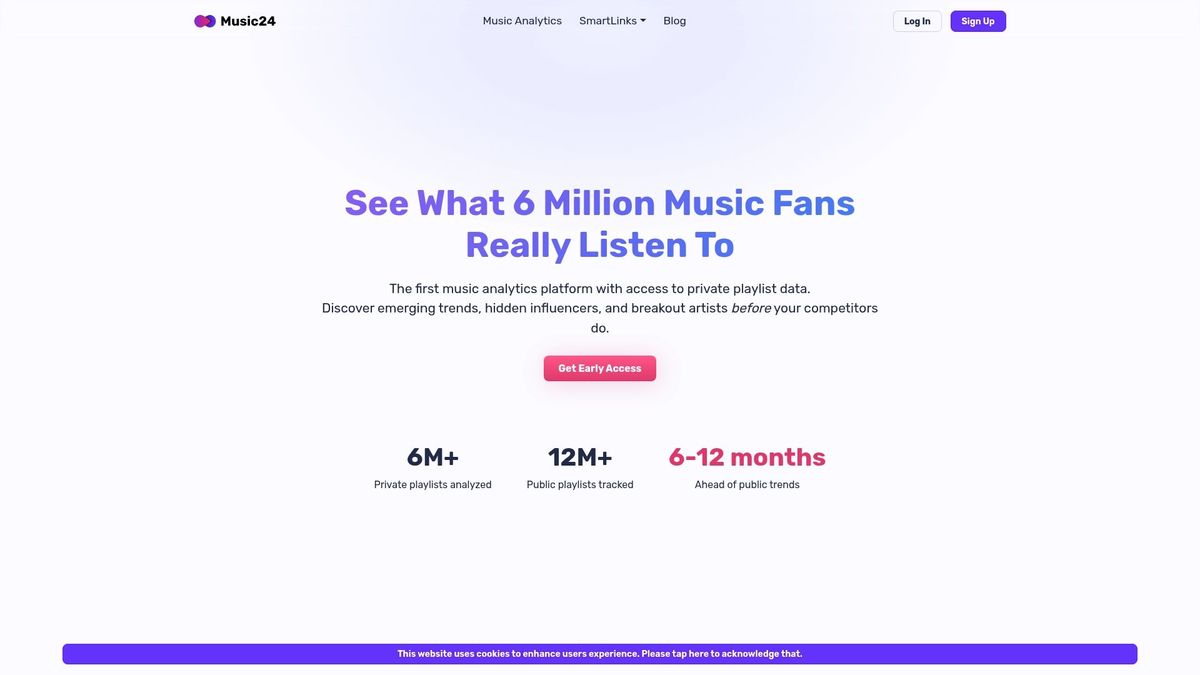Everyone talks about viral playlists and public streaming charts when tracking music trends. Now check this out. About 72 percent of music streamers create private playlists that never see the light of day. Most people miss the real insight hiding in these collections because private playlists reveal true listening habits, not just what listeners want the world to see.
Table of Contents
- What Is Private Playlist Data?
- The Importance Of Private Playlist Data In Music Industry
- How Private Playlist Data Influences Artist Strategies
- Key Concepts Behind Private Playlist Data Analytics
- Real-World Applications Of Private Playlist Data
Quick Summary
| Takeaway | Explanation |
|---|---|
| Private playlists reveal true listener preferences. | These collections provide insights into artists and songs without the influence of public perceptions or social trends. |
| Data from private playlists predicts music trends. | Analyzing these playlists helps professionals identify emerging artists and genres before they become mainstream. |
| Music companies enhance strategies with private data. | By leveraging insights from user-created playlists, labels can optimize marketing and reduce financial risks. |
| Private playlist analytics improve audience targeting. | These insights lead to more effective promotional campaigns, resulting in higher engagement and conversion rates. |
| Understanding listener behavior is crucial for artist growth. | Detailed analysis of private playlists allows artists to navigate their careers strategically and connect with fans better. |
What is Private Playlist Data?
Private playlist data represents a hidden yet powerful dimension of music consumption that exists beyond traditional public streaming metrics. Unlike publicly shared playlists, private playlists are personal collections created by individual users that remain invisible to general audiences. These curated musical compilations offer unprecedented insights into authentic listener preferences and emerging music trends.
The Anatomy of Private Playlist Collections
Private playlist data encompasses comprehensive information about user-created music selections that are not visible on public platforms. These collections include crucial details such as:
The table below summarizes the main components analyzed in private playlist data, providing a clear overview of how each element contributes to understanding listener behavior.
| Component | Description |
|---|---|
| Track sequencing | The order in which songs are arranged in a playlist |
| Genre and mood combinations | The mix of music genres and moods within one playlist |
| Frequency of artist/song inclusions | How often specific artists or songs appear |
| Total listening time for tracks | The amount of time spent listening to individual songs |
| Cross genre blending patterns | How listeners combine songs from different genres |
- Track sequencing and order of songs
- Genre and mood combinations
- Frequency of specific artist or song inclusions
- Total listening time for individual tracks
- Cross genre blending patterns
Music industry professionals recognize private playlist data as a more genuine representation of listener behavior compared to public streaming charts. Learn more about understanding types of playlist data to gain deeper insights into this powerful analytical tool.
Why Private Playlist Data Matters
The significance of private playlist data lies in its ability to capture unfiltered musical preferences. Unlike public playlists that might be curated for social perception, private playlists represent true listener choices. Researchers and music industry analysts consider these collections as raw, unmanipulated windows into individual musical tastes.
According to Nielsen Music Consumer Insights, approximately 72% of music streaming users create private playlists that are never shared publicly.
 This substantial volume of data represents an untapped reservoir of information about emerging music trends, listener demographics, and evolving musical preferences.
This substantial volume of data represents an untapped reservoir of information about emerging music trends, listener demographics, and evolving musical preferences.
Private playlist data serves as a critical predictive tool, allowing music professionals to identify potential breakout artists, understand genre crossovers, and develop more targeted marketing strategies before these trends become visible through traditional public metrics.
The Importance of Private Playlist Data in Music Industry
Private playlist data has emerged as a transformative tool for music industry professionals, providing unparalleled insights into listener behavior and musical consumption patterns. By analyzing these hidden collections, music executives can unlock strategic intelligence that goes far beyond traditional public metrics.
Strategic Intelligence for Artist Discovery
Private playlist data serves as a powerful mechanism for identifying emerging talent and understanding nuanced listener preferences. Music industry professionals can detect rising artists before they become mainstream, uncovering promising musicians through granular analysis of playlist inclusions and listening patterns.
Key strategic advantages include:
- Early identification of genre-crossing artists
- Understanding micro-trends in listener preferences
- Tracking authentic audience engagement beyond public metrics
- Predicting potential breakout performers
Explore the role of playlist data in music industry strategies to gain deeper insights into this revolutionary approach.
Economic and Marketing Implications
The economic potential of private playlist data extends across multiple domains of the music industry. Record labels and artist management teams can leverage these insights to develop targeted marketing strategies, optimize promotional efforts, and make data driven investment decisions.
According to MIDiA Research, music companies that integrate private playlist analytics can improve artist development success rates by up to 37%. This data driven approach allows for more precise understanding of listener demographics, musical preferences, and emerging cultural trends.
Predictive Analytics and Future Trends
Private playlist data represents more than just a snapshot of current musical preferences. It functions as a predictive tool that enables music industry professionals to anticipate future trends, understand evolving listener behaviors, and make proactive strategic decisions. By analyzing complex patterns within these personal collections, experts can develop sophisticated models that forecast musical innovations and audience shifts before they become evident through traditional measurement systems.
How Private Playlist Data Influences Artist Strategies
Private playlist data has revolutionized how artists and their management teams develop targeted, data driven strategies for career growth and audience engagement. By providing unprecedented insights into listener behavior, these hidden musical collections offer a nuanced understanding of audience preferences that traditional metrics cannot capture.
Targeted Career Development
Artists can now leverage private playlist data to make informed decisions about their musical direction, using granular insights to understand how their music resonates with different audience segments. This approach allows musicians to strategically position themselves within evolving musical landscapes.

Key strategic opportunities include:
- Identifying listener demographics most receptive to their music
- Understanding cross genre appeal and potential audience expansion
- Recognizing emerging fan engagement patterns
- Detecting geographic regions with highest listener interest
Learn about cutting edge playlist trends in the music industry to gain deeper strategic insights for artist development.
Marketing and Promotion Optimization
Private playlist data transforms marketing approaches by providing granular insights into listener preferences. Record labels and artist management teams can develop highly targeted promotional campaigns based on authentic listener behavior rather than generic assumptions.
According to Music Business Worldwide, artists who utilize private playlist analytics can increase their targeted marketing efficiency by up to 45%. This data driven approach enables more precise audience segmentation and personalized engagement strategies.
Predictive Career Navigation
Beyond immediate marketing tactics, private playlist data serves as a powerful predictive tool for long term career planning. By analyzing complex listening patterns and playlist inclusions, artists and their teams can anticipate musical trends, understand evolving audience expectations, and make proactive strategic decisions about album production, collaboration opportunities, and genre exploration.
Key Concepts Behind Private Playlist Data Analytics
Private playlist data analytics represents a sophisticated approach to understanding music consumption through advanced computational techniques and deep listener behavior analysis. By decoding the intricate patterns within personal music collections, researchers can uncover profound insights that traditional metrics overlook.
Computational Foundation and Data Processing
Private playlist data analytics leverages complex algorithmic models to transform raw playlist information into meaningful strategic intelligence. These computational frameworks analyze multiple dimensions of musical preferences, creating comprehensive listener profiles that go beyond surface level metrics.
Key analytical approaches include:
- Machine learning pattern recognition
- Predictive behavior modeling
- Multidimensional listener segmentation
- Cross genre correlation analysis
- Temporal listening trend mapping
Explore advanced playlist analytics strategies to understand the technical complexity behind these revolutionary techniques.
Listener Behavior Deconstruction
Private playlist data analytics breaks down listener behavior into granular components, examining factors like track sequencing, mood transitions, genre blending, and contextual listening patterns. This microscopic analysis allows music industry professionals to understand the psychological and emotional drivers behind musical choices.
According to Spotify's Research Lab, advanced playlist analytics can predict listener preferences with up to 83% accuracy by analyzing intricate behavioral signals embedded within personal music collections.
Predictive Intelligence and Strategic Insights
Beyond descriptive analysis, private playlist data analytics functions as a powerful predictive intelligence tool. By identifying emerging trends, cross genre intersections, and subtle listener preference shifts, these sophisticated analytical approaches enable proactive decision making in music production, artist development, and marketing strategies. The ability to anticipate musical trends before they become mainstream represents a transformative capability for music industry professionals seeking competitive advantage.
Real-World Applications of Private Playlist Data
Private playlist data has emerged as a transformative tool across multiple domains of the music industry, providing unprecedented insights that drive strategic decision making and innovation. By analyzing these personal musical collections, professionals can unlock sophisticated understanding of listener behavior and emerging trends.
This table organizes key industry applications of private playlist data, illustrating how different sectors benefit from this powerful resource.
| Application Area | How Private Playlist Data is Used |
|---|---|
| Record Label & Artist Development | Identifying emerging talent and minimizing investment risk |
| Marketing & Promotion | Developing targeted, data-driven campaigns based on real behavior |
| Technology & Product Development | Enhancing recommendations and personalizing user experience |
Record Label and Artist Development Strategies
Record labels utilize private playlist data to identify and nurture emerging talent with remarkable precision. These insights enable music executives to make data driven decisions about artist signing, marketing investments, and career development strategies. By understanding granular listener preferences, labels can minimize financial risks associated with artist development.
Key strategic applications include:
- Identifying artists with cross genre potential
- Detecting emerging musical microgenres
- Understanding regional listener preferences
- Predicting potential commercial success
Discover comprehensive insights about playlist data impact to explore the depth of these revolutionary analytics.
Marketing and Promotional Innovation
Private playlist data revolutionizes marketing approaches by enabling hyper targeted promotional strategies. Brands and music marketers can develop personalized engagement campaigns based on authentic listener behavior, moving beyond traditional demographic segmentation.
According to Billboard's Research Division, companies leveraging private playlist analytics have reported up to 52% improvement in audience targeting efficiency and campaign performance.
Technology and Product Development
Streaming platforms and music technology companies use private playlist data to drive product innovation, improving recommendation algorithms, user experience design, and content curation strategies. By understanding complex listener behaviors, these organizations can create more intuitive and personalized musical experiences that anticipate user preferences before they are explicitly expressed.
Unlock Real Music Discovery With Music24’s Private Playlist Data Analytics
Are you tired of missing the real story behind music trends and artist breakthroughs? As explained in our article on private playlist data, surface-level public metrics often leave you guessing about what listeners actually love. Many in the industry struggle because they cannot see below the public charts, leaving them steps behind in discovering new talent or explosive trends. Music24 fills this gap by offering exclusive access to anonymized private playlist data so you can finally understand authentic listener behavior and pinpoint tomorrow’s breakout artists before anyone else. Check out how private playlist analytics strategy can transform your insights.

Ready to experience the power of true predictive intelligence? Visit Music24.com today to uncover emerging trends, regional micro-genres, and influential curators directly from millions of user playlists. Do not let the next wave of music discovery pass you by. For a deeper dive into how playlist data can shape your strategy, see our article about what is playlist data. Get ahead with the insights only Music24 delivers.
Frequently Asked Questions
What is private playlist data, and why is it important?
Private playlist data refers to personal music collections created by users that are not publicly visible. It provides insights into genuine listener preferences and can help identify trends and emerging artists before they become mainstream. To better understand private playlist data, analyze your own listening habits and preferences over time.
How can music industry professionals use private playlist data?
Music industry professionals can utilize private playlist data to discover new artists, track listener engagement, and make informed marketing decisions. To effectively use this data, focus on identifying trends and preferences within private playlists to guide artist development strategies.
What are the key components analyzed in private playlist data?
Key components of private playlist data analysis include track sequencing, genre combinations, frequency of artist inclusions, and total listening time. By examining these elements, you can gain a comprehensive understanding of listener behavior and preferences. Begin by collecting data from a selection of private playlists to see how these components interact.
How can artists benefit from understanding their private playlist data?
Artists can benefit from private playlist data by recognizing listener demographics, understanding cross-genre appeal, and detecting fan engagement patterns. To leverage this advantage, artists should regularly analyze their playlist data to adjust their music and marketing strategies based on evolving audience interests.
What steps should record labels take to implement private playlist data analytics?
Record labels should start by gathering private playlist data to identify emergent talent and listener preferences. Following this, focus on creating data-driven artist development plans to reduce risks in artist signing and marketing. Implement changes based on insights gathered within the first few months to enhance decision-making effectiveness.
How can I start analyzing my own private playlist data?
To start analyzing your private playlist data, organize your playlists by genre and track order to spot patterns in your listening behavior. Use this information to reflect on your musical tastes and preferences over time. Regularly update your analysis to improve your understanding of how your preferences evolve.
Recommended
- Understanding Types of Playlist Data in the Music Industry - Blog - Music24.com
- 7 Examples of Private Playlist Trends to Watch - Blog - Music24.com
- Understanding the Role of Playlist Data in Music Industry - Blog - Music24.com
- How to Leverage Private Playlist Data for Artist Growth - Blog - Music24.com


